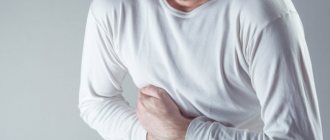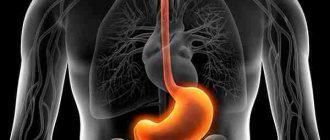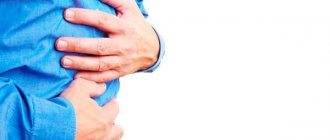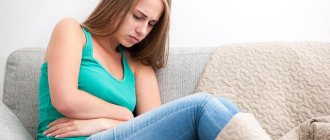Main reasons
If both the stomach and the back hurt at the same time, then doctors first of all suspect that they are affected by an inflammatory or degenerative pathology. This combination of uncomfortable sensations is not so rare. And all because of the commonality of innervation - communication between nerves and the central nervous system. Severe pain accompanies the course of many stomach diseases, for example, erosive gastritis. It is not always localized directly in the epigastric region, but spreads along the nerve, extending into the spine at the level of the chest.
An interesting fact is that this combination of painful sensations can occur in the absence of stomach and back problems. Its causes include damage to organs located both nearby and at a considerable distance:
- Pathologies of the urinary system in the acute stage are manifested by such acute pain that they are felt throughout the entire abdominal cavity. This is typical for renal failure, pyelonephritis, glomerulonephritis;
- Intestinal pathogens, if left untreated, quickly spread throughout the entire digestive tract, causing severe inflammation of its walls. The more pronounced it is, the higher the likelihood of pain in the sternum and lower back;
- when stones pass from the gall or bladder, piercing pain occurs, radiating to the back, groin and even hip joints;
- due to the formation of a hernia in the groin area, muscle tissue is periodically pinched, causing acute pain. But it is especially strong when it compresses a sensitive nerve ending;
- the development of an infectious process in the urethra, ureters, bladder only at the initial stage is manifested by localized pain. As pathogenic microorganisms ascend towards the kidneys, they spread to the peritoneum and are felt in the stomach and spine.
In men, a similar combination of unpleasant sensations is observed with acute inflammation of the prostate gland, vesicles, and urethra. In women - with severe erosive damage to the appendages, uterus and ovaries, as well as the formation of fibroids. In such cases, the cause of pain in the stomach and back is not difficult to determine, since in the area of the genitourinary system they are felt much more strongly.
Pain in the lower abdomen and back in women
The cause of simultaneous abdominal and back pain in women may be:
- Premenstrual illness;
- Bend of the uterus;
- Myoma;
- Adnexitis (salpingoophoritis);
- Endometriosis;
- Twisting of the cyst stalk;
- Ectopic pregnancy;
- Rupture of the ovary or oviduct;
- Risk of miscarriage;
Complications during pregnancy
Pain in the lower abdomen and back in women during pregnancy indicates the development of complications - placental abruption, increased tone of the uterus, changes in the condition of the fetus, etc. Such symptoms may indicate a danger not only to the fetus, but also to the life of the mother, so you should immediately see a gynecologist and undergo the necessary examinations.
It is possible that pain in the abdomen and back in women in the early stages of pregnancy occurs due to the fact that the fertilized egg has not reached the uterus, but has become embedded in the fallopian tube. An ectopic pregnancy is a direct indicator of emergency surgery. If detected late, serious health consequences or death may occur.
Read also: Herpes on the back
Diseases of the genitourinary system
Pain in the back and lower abdomen may indicate inflammation of the bladder, appendages, or infections in the pelvic organs. Often the painful sensation is accompanied by frequent urination, burning, discharge, and increased body temperature.
Therapy can only be chosen after an accurate diagnosis has been made, so contact with specialists is necessary.
Pain in the lower abdomen and back in men may indicate prostatitis, inguinal hernia or genitourinary tract infections.
Since the same symptoms have pathologies that require immediate treatment, for example, appendicitis, it is not recommended to self-medicate. A timely visit to a specialist will alleviate the condition and avoid complications. If it is not possible to call an ambulance, then you can relieve the pain attack a little by taking a dose of an antispasmodic and go to a medical facility on your own.
Intestinal obstruction
Aching pain in the abdomen, reflected in the back and, less commonly, the groin, may indicate intestinal obstruction. Other symptoms of pathology:
- Colic, spasms;
- Increased body temperature;
- Nausea, vomiting - the vomit is foamy and has a distinct smell of feces. Also, they may contain particles of feces;
- The stool is scanty, thin or completely absent for several days.
Intestinal obstruction - possible causes.
Intestinal obstruction is treated exclusively by surgery. The cause of the pathology may be adhesions after previous operations, diseases of the gastrointestinal tract, tumors, metastases and other phenomena.
Gastrointestinal problems
Can your stomach and back hurt for natural reasons? It’s rare, but it does happen. For example, due to banal indigestion after eating fatty, fried foods. Enzymes and hydrochloric acid do not cope with their work, so the food bolus stagnates in the stomach. This leads to the development of putrefactive and fermentative processes, the appearance of heartburn, sour belching, and severe pain in the epigastric region. They spread along the nerves to the thoracic segments of the spine, and when the intestines are involved, they extend to the lower back.
This is also possible during pregnancy. Hormonal fluctuations and changes in eating habits do not contribute to proper digestion. The situation is aggravated by compression of the nerve endings by the ever-growing uterus. But consultation with a doctor is necessary even in a single case of general pain syndrome. After all, it is also characteristic of pathologies of the urinary and reproductive systems.
Pancreatitis
Severe pain may indicate another exacerbation of chronic pancreatitis. Due to inflammation of the pancreas, the enzymes it secretes are not released into the duodenum, which leads to digestive disorders. Violation of its intra- and exocrine function is manifested by the following symptoms:
- severe pain in the upper abdomen and left hypochondrium;
- dyspeptic disorders - nausea, vomiting, heartburn;
- yellowness of the skin and sclera.
With inflammation of the pancreas, pain from the stomach area spreads to the spinal column
If the patient follows all medical recommendations, the prognosis is favorable. A violation of the diet, drinking alcoholic beverages, and smoking lead to the progression of degenerative processes in the tissues of the gland, the development of severe complications, many of which require surgical intervention and can be fatal.
Gastritis and ulcerative lesions
With any of these pathologies, pain from the epigastrium can radiate to the back, masquerading as thoracic or lumbar osteochondrosis. This condition occurs especially often with erosive and hypoacid gastritis. In the first case, the cause of burning pain is the contact of hydrochloric acid or foods saturated with salt and spices on exposed areas of the mucous membranes. And with hypoacid gastritis, insufficient gastric juice is produced, which provokes stagnation of the food bolus, bloating, and excessive gas formation.
Even more often, pain in the stomach and any part of the back occurs together when an ulcer forms. It is formed as a result of the simultaneous weakening of the protective mechanisms of the mucous membrane, exposure to aggressive internal factors, and a disorder of the evacuation function of the digestive tract. For example, due to gastric hypokinesia, duodenogastric reflux.
Ulcerative lesions are characterized by frequent alternation of periods of remission and relapses. During exacerbation, pain appears and quickly increases in the epigastrium and in the area of the xiphoid process of the sternum. If the pathology is localized directly in the body of the stomach, then discomfort is felt on the left. When an ulcer forms in the pyloric region - on the right. Quite often the pain radiates to the lower back and radiates between the shoulder blades.
IMPORTANT! With atypical forms of peptic ulcer, pain may occur in the iliac region (identical to inflammation of the appendix), in the heart (cardiac), and in the lower back (radiculopathy).
Oncological pathologies
A malignant tumor of the stomach arises from the cells of the mucous layer and gradually spreads to the muscular and serous layers. When it grows into the blood vessels, gastric bleeding occurs, predisposing to severe anemia, general weakness, and high fatigue. The formation and gradual enlargement of a malignant tumor is also manifested by the following symptoms:
- weight loss as a result of suppressed appetite, impaired absorption of nutrients, vitamins, minerals;
- shortness of breath even after minor physical exertion;
- fever, chills, cold sweat;
- temperature fluctuations above subfebrile values (37.1-38.0°C);
- enlarged lymph nodes.
The growing tumor puts more and more pressure on the nerve roots, so the intensity of the pain steadily increases. Quite quickly they begin to be felt in the lower abdomen and back, spreading throughout the spinal column.
Cholecystitis
This is the name of an inflammatory lesion of the gallbladder, which is characterized by pain in the right hypochondrium, radiating to the right arm and collarbone, nausea, vomiting, diarrhea, and flatulence. Exacerbation of cholecystitis is preceded by emotional stress, dietary errors, and alcohol abuse. When cholecystocardial syndrome occurs, dull pain in the upper back, tachycardia, and heart rhythm disturbances occur.
The acute course of cholecystitis is complicated by severe stomach pain radiating to the back
Uncomfortable sensations are most pronounced during the period of exacerbation or after exposure to provoking factors. During remissions, pain in the back and stomach is rarely a concern. But in some patients it is permanent, which negatively affects not only their physical, but also their psycho-emotional state.
Appendicitis
This is a fairly common pathology that is diagnosed mainly in children, adolescents and young adults. As a result of acute, less often chronic inflammation of the cecal appendage, acute pain occurs in the right iliac region. They are not clearly localized, but radiate to the lower back and lower chest. At the same time, digestion is disrupted, the person suffers from attacks of nausea and vomiting, chills, and fever.
At the initial stage of development of the inflammatory process, pain is felt in the epigastric and periumbilical areas. If the appendix is located atypically, then it soon appears in the right hypochondrium, lower back, pelvic organs, above the pubis. Regardless of the intensity of the pain, the prognosis is favorable - the person recovers completely in about a month.
ATTENTION! Appendicitis is dangerous due to its complications - the formation of an inflammatory infiltrate, interintestinal abscess, and adhesive intestinal obstruction. Death is possible with delayed hospitalization and untimely surgical intervention.
Characteristics for various pathologies
Pain syndrome in the abdominal area can have a different character , and depending on its characteristics, you can, if not recognize, then at least suspect the cause of the discomfort.
- A dull aching pain is observed during inflammatory processes in the gastric mucosa (gastritis), as well as during chronic pancreatitis, and in this case it most often has a girdling character. In some cases, dull pain may indicate the onset of appendicitis.
- Acute attacks always indicate serious pathologies that require immediate medical attention. These sensations may be present with a heart attack and other disorders of the cardiovascular system, perforated ulcer, acute pancreatitis, cholecystitis, etc.
- Pressing pain is usually associated with disorders of the gastrointestinal tract (gastritis, ulcers, pancreatitis), especially if they occur after eating. Sometimes it indicates ischemia, angina pectoris and other pathologies of the cardiovascular system. Another reason is intestinal obstruction, and the pain syndrome in this case is quite mild.
- Attacks of sharp pain indicate acute pancreatitis , cholecystitis, perforated ulcer, renal or hepatic colic, as well as myocardial infarction.
Attention: pain that occurs due to disorders of the digestive tract is usually associated with food intake - they occur before or after eating, as well as after eating certain foods (fatty, fried, spicy, etc.).
Renal colic
Most often, renal colic occurs against the background of urolithiasis, which is characterized by the formation of stones in the bladder. Somewhat less frequently, they can be triggered by injuries or tuberculous kidney damage, benign and malignant neoplasms, and pyelonephritis. With renal colic, the pain is sharp, burning, piercing, and can cause fainting. They are localized in the lower back, and then begin to spread down the ureter. Due to the common innervation, severe pain in the lower part of the stomach is possible. Associated symptoms are:
- frequent and painful urination;
- nausea and vomiting;
- psychomotor agitation.
Even parenteral administration of non-steroidal anti-inflammatory drugs is often not enough to relieve pain. Only narcotic analgesics can cope with them.
Peptic ulcer
Exacerbation of pathology can cause painful symptoms. Characteristic signs of an unpleasant disease are:
- Sudden onset of sharp pain in the abdominal area. It appears a few minutes after eating food.
- The patient experiences nausea. This is followed by sour vomiting, after which the patient feels some relief.
- Discomfort often occurs on an empty stomach. Night pains constantly appear. They disappear after eating.
- The pain is combined with heartburn.
- With physical activity, discomfort in the epigastric area increases significantly. The sensation decreases at rest. The patient experiences relief in a position where the legs are bent and pressed to the stomach.
- Discomfort can even spread to the chest.
- The patient experiences unbearable sensations if the stomach hurts and radiates to the lower back.
Spinal diseases
People suffering from pathologies of the digestive tract experience stomach pain quite often. Therefore, at first they do not pay attention to the fact that the discomfort is felt from behind - in the back. And at this time, a degenerative-dystrophic disease develops in one of the parts of the spine. With timely treatment, it can be quickly eliminated.
Osteochondrosis
Simultaneous pain in the back and at the level of the stomach is a typical sign of the progression of thoracic osteochondrosis. As the body naturally ages, the cartilage tissue of the intervertebral discs is destroyed. They become dehydrated, crack, and lose their ability to absorb shock loads. At the first stage of osteochondrosis, symptoms almost do not arise - their intensity increases at the 2nd stage of development of the pathology.
Why does my back hurt below my ribs?
Why do both the stomach and the back in the area of the thoracic vertebrae hurt at the same time:
- due to the thinning of the intervertebral discs, the vertebral bodies begin to deform;
- bone tissue grows with the formation of growths - osteophytes;
- when the spinal root is compressed by a growth, the spine begins to ache;
- pain spreads along the nerves and is felt not only in the stomach, but also in the liver and small intestine.
Due to disruption of the innervation of internal organs, symptoms of gastritis, gastric and duodenal ulcers occur in the form of digestive disorders and peristalsis. Therefore, patients with thoracic osteochondrosis turn not to a neurologist or vertebrologist, but to a gastroenterologist. Only after a thorough diagnosis does the true cause of poor health become clear.
When the spine is affected by osteochondrosis, pain is felt not only in it, but also in the stomach
THIS IS INTERESTING! An experienced diagnostician is able to quickly determine the cause of nausea, vomiting, heartburn, and stomach pain. Unlike gastrointestinal pathologies, with osteochondrosis the appearance of such symptoms is not associated with the nature of nutrition or changes in the daily menu.
Intervertebral thoracic hernia
Intervertebral hernia is formed at stages 2-3 of osteochondrosis. In a patient, due to loss of stability of a certain vertebral segment, the intervertebral disc protrudes between the vertebral bodies. The leading symptoms of a hernia from the musculoskeletal system are tonic muscle tension and limitation of movements in the affected area of the spine. When the spinal roots, blood vessels and spinal cord are compressed, signs of damage to other vital systems appear. The nature of the symptoms depends on the location of the hernial protrusion:
- upper thoracic region - pain in the upper parts of the chest, disorders of esophageal motility, difficulty swallowing;
- mid-thoracic region - unilateral or bilateral girdle pain along the intercostal nerves, pain in the stomach, dyspepsia, pancreatic enzyme deficiency, carbohydrate metabolism disorders;
- lower thoracic region - pain under the ribs, in the upper abdomen, intestinal dyskinesia.
A hernia manifests itself as an aching, dull painful sensation in the back. Gradually, the protrusion becomes larger and puts a lot of pressure on the nerve endings. Now one awkward movement (turning or bending) is enough to cause a piercing, shooting pain in the back, which will radiate to the stomach.
Why does it occur
Pain in the stomach can indeed radiate to the back on the right or left , most often in the hypochondrium or between the shoulder blades, less often in the lower back.
This is due to the fact that the nerve endings of the abdominal organs represent a single network with the nerve fibers of the back and spinal cord, as a result of which discomfort is felt in several places at once.
Only a doctor can determine the exact cause of the discomfort.
If you experience abdominal pain radiating to the back, you should not discount cardiovascular pathologies, since they can also be accompanied by similar manifestations.
How to get rid of discomfort
If, in addition to the stomach, your back begins to hurt or vice versa, then it is not advisable to hope for a quick disappearance of the symptoms. Like swallowing painkillers by the handful. Pain syndrome is only a protective reaction of the body, with which the central nervous system signals about problems that have arisen. It is necessary to consult a doctor: neurologist, vertebrologist, gastroenterologist. A visit to a therapist would not be a mistake either. He will prescribe the necessary diagnostic measures, and then refer the patient for further treatment to a specialist doctor. Before visiting a medical facility, you can cope with aching, dull pain on your own. What do we have to do:
- take an antispasmodic, for example, No-shpa or domestic Drotaverine;
- Apply Fastum, Artrosilene, Diclofenac ointments to your back.
To eliminate stomach and spinal pain, the use of analgesics is not enough - it is necessary to determine their cause
It is strictly forbidden to warm the back or stomach area, including with burning ointments. In the presence of an acute inflammatory process, it will spread to healthy tissues and organs.
With combined pain in the stomach and spine, the situation cannot be corrected with the help of analgesics. It is necessary to establish the cause of periodic or constant pain, and then undergo a full course of treatment.
Treatment
If the cause of discomfort in the stomach and back is a perforated ulcer , acute pancreatitis or a heart attack, the patient requires therapy in a medical facility. Treatment at home is possible only after diagnosis and consultation with a specialist.
Medication
There are several categories of drugs used to eliminate stomach pain , and it is necessary to choose the appropriate drugs depending on the cause of the discomfort and the general condition of the patient.
- Antispasmodics . No-shpa, Papaverine, Drotaverine and their analogues relieve spasms of smooth muscles and relieve pain.
- Antacids . The drugs prevent excessive secretion of hydrochloric acid, eliminate heartburn, heaviness and abdominal pain, the most common drugs are Maalox, Gaviscon, Almagel, etc.
- Enzyme preparations . Necessary for insufficient production of digestive enzymes to improve the digestion process, examples are Festal, Creon, Pancreatin, Mezim.
- Proton pump blockers . A group of drugs that protect the gastric mucosa from high acidity and promote regenerative processes, which include Ameprozole, Pantoprazole, etc.
It is strictly not recommended to take aspirin, Analgin, Ibuprofen and other similar drugs with caution for stomach pain, as they can cause worsening of the condition, and in some cases, internal bleeding.
Diet
Taking medications for stomach pain must be combined with proper nutrition . Food should be taken in small portions at the same time, dishes should have a semi-liquid consistency and moderate temperature (neither cold nor hot).
You should refuse:
- fried,
- fatty,
- salty,
- spicy and smoked dishes,
- fast food,
- semi-finished products and other products containing chemical additives.
The diet must include fermented milk products, pureed soups and cereals, boiled vegetables, bread with bran, non-acidic fruits, preferably baked.
Folk remedies
Treatment with folk remedies can also be used only after consultation with a doctor . Most often, infusions and decoctions of medicinal herbs are used to eliminate unpleasant sensations - chamomile, calendula, centaury, cucumber, raspberry and currant leaves.
A good effect is given by flaxseed (pour a tablespoon of seeds into a glass of boiling water, leave overnight, then drink the liquid in several doses), honey, propolis, sea buckthorn, freshly squeezed potato juice.
If discomfort is accompanied by constipation, you need to eat boiled beets, dried fruits, plums; for diarrhea, bananas, apples, green beans, and eggplants are useful.
When to call an ambulance
If unpleasant sensations at the level of the stomach and back appear suddenly, resembling attacks and gradually subside on their own, then this may be an exacerbation of chronic pathologies.
As soon as possible, you should visit a doctor and undergo an examination, it will help identify the causes of deterioration in health.
But if the condition is accompanied by acute pain and there is a tendency for it to intensify, rapid vomiting, diarrhea, excessive sweating, abnormal heartbeat and blood pressure, semi-fainting, increased low-grade temperature, urination mixed with blood, then it is necessary to urgently call an ambulance.
Inflammation of the pancreas
In case of acute inflammation of the gland, the patient experiences abdominal pain radiating to the lower back. Discomfort appears as a result of an acute attack of pancreatitis. With this pathology, pancreatic tissue is destroyed. The close location of the gland and the lower back causes discomfort in the lower back.
The main symptoms of pancreatitis are:
- girdle pain;
- vomiting that does not bring relief to the patient;
- the occurrence of nausea;
- dry mouth;
- belching;
- hiccups;
- rapid pulse;
- hyperthermia;
- increased blood pressure;
- dyspnea;
- sticky sweat;
- the skin becomes pale;
- the face becomes sharper.
When your stomach hurts due to back problems
Pain in the stomach area is sometimes a consequence of pathologies of the spinal column. Often this condition is observed with osteochondrosis of the thoracic or lumbar region.
Degenerative changes lead to a change in the location of the intervertebral discs, which affects the spine and neighboring organs.
In addition, pinching of the nerve roots may occur, which causes acute pain. Associated symptoms include heartburn and nausea, which is why this pathology is difficult to distinguish from problems with the gastrointestinal tract.










